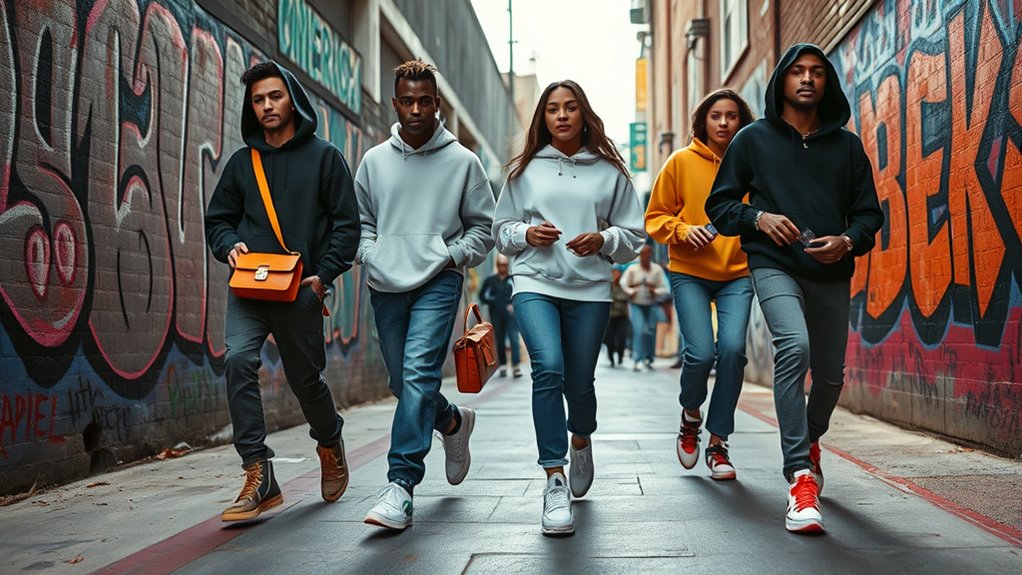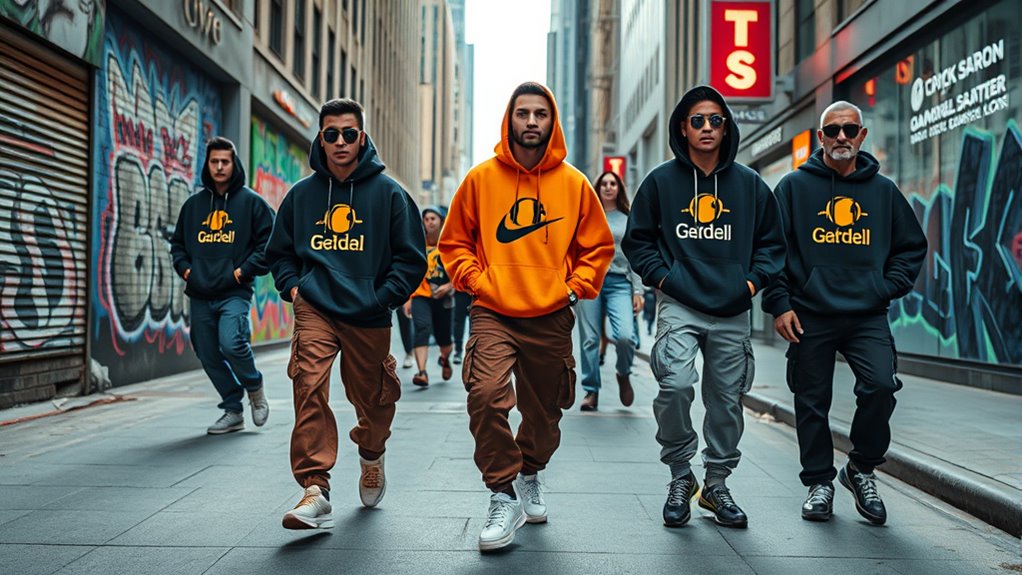Streetwear’s journey from hip-hop and skate culture to high fashion is driven by strategic collaborations with luxury brands, limited-edition drops, and a focus on exclusivity. As brands like Louis Vuitton and Gucci partner with streetwear labels, they elevate casual styles to luxury status, blurring boundaries between everyday wear and runway trends. Sneakers and logo-driven aesthetics have become symbols of identity and status. Want to explore how these trends evolved and continue shaping fashion today?
Key Takeaways
- Collaborations between luxury brands and streetwear labels elevated streetwear into high-end fashion.
- Sneaker culture’s hype and exclusivity made street-inspired footwear desirable in luxury markets.
- Fashion weeks integrated streetwear aesthetics, blending casual and formal styles on runways.
- Iconic partnerships like Louis Vuitton x Supreme bridged urban culture with luxury branding.
- The ongoing fusion reflects a cultural shift, transforming streetwear into a symbol of status and sophistication.

Streetwear and high fashion may seem worlds apart, but in recent years, they’ve become more intertwined than ever. This fusion isn’t accidental; it’s driven by a shared desire for innovation, exclusivity, and cultural relevance. One of the biggest factors bridging the gap is luxury collaborations. High-end brands have teamed up with streetwear labels and sneaker companies to create limited-edition pieces that excite both worlds. Think of iconic partnerships like Louis Vuitton and Supreme or Gucci’s collabs with Nike. These collaborations elevate streetwear’s status, turning everyday comfort into coveted luxury items. They also redefine what’s possible for high fashion, making runway styles more accessible and rooted in contemporary culture.
Luxury collaborations blur streetwear and high fashion, transforming casual styles into coveted symbols of innovation and cultural relevance.
At the heart of this transformation is sneaker culture. Sneakers, once purely athletic footwear, have become symbols of identity and status. The hype around limited releases, sneaker drops, and exclusive collaborations fuels a global community that values rarity and authenticity. When brands like Adidas, Nike, or New Balance release special editions in collaboration with top designers or artists, they create a buzz that extends far beyond sports or casual wear. These sneakers become collectibles, status symbols, and a form of self-expression. Their influence seeps into high fashion, inspiring runway shows and luxury collections to incorporate sneaker-inspired aesthetics. High-end designers now often include sneakers in their collections, blurring the lines between casual and couture.
This cultural shift isn’t just about footwear or merchandise; it’s about redefining what luxury means. The once rigid boundaries between streetwear and high fashion have softened, allowing designers to experiment with street-inspired silhouettes, logos, and aesthetics. Fashion weeks feature models in oversized hoodies paired with tailored pieces, and runway shows incorporate sneakers alongside traditional heels. The rise of streetwear’s influence means that luxury brands now seek to tap into its energy, authenticity, and connection with youth culture to stay relevant.
You’re part of this evolving landscape, where the boundaries of fashion continuously expand. The fusion of streetwear and high fashion isn’t just a passing trend; it’s a reflection of how culture, commerce, and creativity intersect. Thanks to luxury collaborations and sneaker culture, what was once considered everyday casual wear has now become a statement of style and status, shaping the future of fashion itself.
Frequently Asked Questions
How Did Streetwear Gain Mainstream Acceptance Beyond Urban Communities?
Streetwear gained mainstream acceptance through cultural integration and retail expansion. You see, brands collaborated with high fashion designers, blending street style with luxury, which attracted a broader audience. Retailers started carrying streetwear in major stores, making it more accessible. As a result, people outside urban communities embraced the look, turning streetwear into a global phenomenon and cementing its place on runways and in everyday fashion.
What Role Did Social Media Play in Blending Streetwear With High Fashion?
Social media played a pivotal role in blending streetwear with high fashion by enabling viral marketing and amplifying influencer impact. When you follow popular influencers sporting streetwear brands, it quickly gains visibility and desirability beyond urban communities. Platforms like Instagram and TikTok allow brands to showcase new collections, connect with fans, and create buzz, making streetwear’s crossover with high fashion inevitable as trends spread rapidly and authentically across diverse audiences.
Are There Specific Designers Who Pioneered the Shift From Streetwear to Runway?
You’ll find urban pioneers like Virgil Abloh and Kanye West truly pioneered the shift from streetwear to runway. They pushed boundaries through innovative designer collaborations with brands like Nike and Louis Vuitton, blending streetwear’s edgy style with high fashion’s sophistication. These designers made it clear that streetwear isn’t just casual wear anymore; it’s a major influence on high fashion’s evolution, shaping the industry’s future in exciting ways.
How Does Streetwear Influence Luxury Brand Collaborations Today?
Imagine vibrant graffiti blending seamlessly into sleek, polished designs—that’s how streetwear influences luxury brand collaborations today. You see it in bold branding strategies and exclusive luxury partnerships that draw from streetwear’s edgy roots. This fusion creates fresh, relatable images for high-end brands, appealing to new audiences. You, as a consumer, get to enjoy innovative collections that balance street authenticity with luxury refinement, making fashion more accessible and dynamic.
What Future Trends Might Shape the Evolution of Streetwear in High Fashion?
You’ll see streetwear evolve with sustainable innovation, making eco-friendly materials a standard. Digital customization will let you personalize pieces, blending tech with style seamlessly. Expect collaborations to focus on eco-conscious practices and interactive designs that engage consumers directly. These trends will keep streetwear fresh, accessible, and aligned with global values, shaping high fashion’s future by making it more sustainable, innovative, and highly personalized for your unique style.
Conclusion
You see it all around—bold logos, oversized fits, and a mix of comfort and luxury. Streetwear has transformed from raw, rebellious roots into polished, runway-ready pieces. It’s a dance of contrast, a blend of past and present, casual and couture. As you walk through your day, notice how this style mirrors your world—dynamic, expressive, unstoppable. Streetwear isn’t just fashion; it’s a movement, a statement, a way to be seen and to be yourself.








